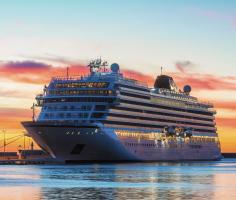
Viking Sky
In early March, a press release announced, “Viking Dominates Cruise Critic’s 2019 Cruisers’ Choice Awards.” Viking’s five 930 passenger ships won ten awards. The Viking Sky received First Place in six award categories within the small to mid-size ship group: Best Overall Ship, Best Cabins, Best Dining, Best for Public Rooms, Best Service and Best Value-for-Money. Viking Sky also beat ships of all sizes to win First Place as Best for First-Timers.
Unfortunately, Viking Ocean Cruises has had its problems. Over the weekend, the Viking Sky came perilously close to ending up on the rocks on the Norwegian coast in high seas and strong winds, following a propulsion failure. When the ship was able to anchor, it was reported to be only 100 meters, or roughly half a ship length, from an underwater reef. Fortunately, roughly half the passengers were evacuated by helicopter. The ship is reported to have lost the use of all four engines. The ship’s crew were subsequently able to put three engines online and, with tug assistance, safely make it to port with the remaining passengers and crew. Around 20 passengers were reported to be injured but there were no fatalities.
The 47,842-tonne ship is only about two years old, having been delivered from Fincantieri in 2017, the third of five sister ships delivered so far. A sixth ship is under construction and scheduled to be delivered this year. So far, there are no reports on how the Viking Sky lost power.
Like most modern cruise ships the Viking Sky has a diesel-electric propulsion plant with four diesel engines driving generators to power electric motors which turn the two propeller shafts. The system should be highly redundant, so it unclear how all four engines were knocked out. It could have been a failure in the electrical distribution system. Or there could have been problems with the fuel, cooling or exhaust systems. Some have suggested that the severe weather might have been a contributing factor. Until we know more, this is all speculation.
That being said this is not the first time that these ships have suffered propulsion problems. In August 2015, just four months after it was delivered, a Baltic and Scandinavian cruise on the Viking Star was cut short by mechanical problems. Viking said the issue was related to the “electric transformers in one part of the ship’s propulsion system”.
The Viking Sea, the second ship of the series, also has been delayed due to propulsion issues. In late December of 2016, the ship was delayed in Barcelona for more than a week with unspecified engine problems. In May of 2017, there were reports of engine problems causing the ship to skip ports on a cruise to Russia and Poland. Then in August, the ship broke down again, this time in Malta.
So far, there have been no propulsion issues reported on the two newest ships of the series, the Viking Sun and the Viking Orion.
Viking has operated river cruises for many years. Its subsidiary, Viking Ocean Cruises, is the first new cruise line to start up in nearly a decade. There are currently plans to build another eleven ships similar to the Viking Sky and her sister ships.

It seems cruise ship propulsion systems have a difficult task. The ships are floating apartment blocks. The mid and large sized ships must be very challenging to maneuver around even the largest port. Their size alone will catch every bit of breeze to be pushed around. I read last year that several shipyards are trying to get a dry dock for the larger ships built in the Caribbean so they don’t have to keep limping back to Europe for propulsion system issues. Apparently minor ground and rock hits are also common for Caribbean routed ships. Anthem of the Seas and her sisters all seem to have had problems when less than 2 years old so not just Fincantieri.
Wartsila must be in a bit of panic with the two failures this last weekend. In sight of each other Viking Sky and cargo vessel Hagland Captain both lost engines. It seems Hagland Captain is Wartsila’s first hybrid retrofit short sea cargo ship. Seems she was delivered in February of this year with the fitting of battery powered engines for short 30 minute use of getting in or out of port with minimum emissions.
My maritime knowledge is minimal but I hope the discussions between professionals will remain more public. Was it shifting engine fuels that triggered a shutdown. Water coming in through air vents. Some other hardware, software or seal issue because of the heavy rolling. I wondered if the heavy seas caused the propellers to be completely out of water (no tension) and then in water with the ship being wind blown (extreme tension) repeatedly and it possibly over straining the entire system. Or causing too much strain on the propeller shaft. Speculation, yes but it keeps us learning.
There is another possibility. Where it has been mentioned that these ships are using computers. There could have been a hacker whom made the bad decision of what would happen if…………
I hope this isnt the case, yet with todays technology it wouldnt surprise me.
Viking Sky: MAN Engines, Volkswagen
Hagland Captain: Wartsila Battery electric Hybrid propulsion system
https://www.wartsila.com/media/news/08-02-2019-wartsila-to-deliver-world-s-first-hybrid-retrofit-for-short-sea-shipping-vessel-2376827
Wartsila has signed retrofit contract in December, so there is no Wartsila engines yet (they probably wish they would). Now she has Mak / GM engines.
Current setup by the owner: https://www.hagland.com/fleet/hagland-captain/